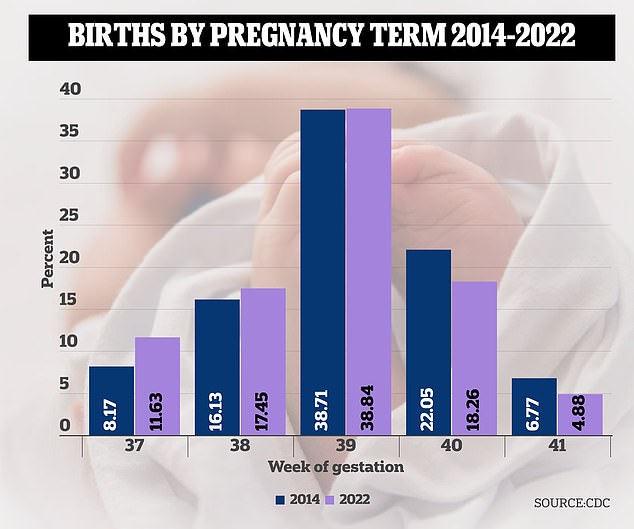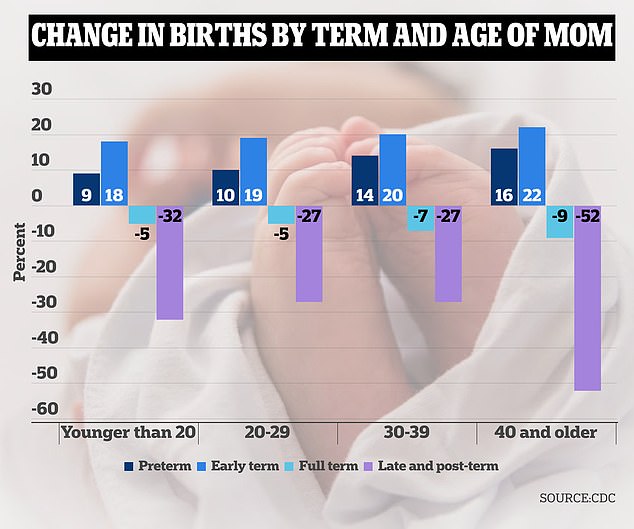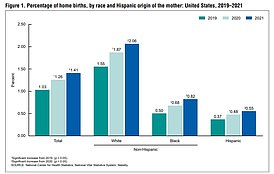The number of premature babies has risen 12% since 2014 as doctors warn of a ‘child health crisis’
The number of babies born prematurely, which puts them at high risk of life-threatening conditions and premature death, has increased by more than 10 percent in the past decade.
A report from the Centers for Disease Control and Prevention found that preterm birth, defined as birth before 37 weeks of pregnancy, increased 12 percent from 2014 to 2022, from 7.7 percent to 8.7 percent.
Preliminary CDC data shows that 3.66 million babies were born in 2022, meaning 318,400 of those children were born prematurely.
Pregnancy is measured in weeks, as vital development during pregnancy takes place almost daily. And this continues until the last weeks of pregnancy.
During those weeks, a baby’s brain, lungs and liver continue to develop, and babies born prematurely – especially before the 32nd week – have a higher mortality rate and disability.
A report from the Centers for Disease Control and Prevention noted fluctuations in birth rates during the 2020-2022 pandemic years, but reported an overall upward trend in premature and early births
The number of premature births at 37 and 38 weeks’ gestation also increased, from eight percent and 11.6 percent respectively in 2014 to 16 and 17.5 percent in 2022.
The number of full-term births, measured as 39 to 40 weeks, and late or post-term births, measured as 41 weeks or later, decreased.
These fell by 6 percent and 28 percent respectively.
The report found that the biggest change in births occurred at 37 weeks, which increased by 42 percent over the eight years measured.
The CDC did note fluctuations in birth rates during the 2020-2022 pandemic years, but reported an overall upward trend in premature and early births.
A separate 2022 CDC report found that about one in 10 babies in the U.S. are born prematurely.
Babies who survive an early birth are at increased risk of developing breathing problems, feeding problems, cerebral palsy, developmental delays, and vision and hearing problems.

Pregnancy is measured in weeks, as vital development during pregnancy takes place almost daily. And this continues until the last weeks of pregnancy

Rates of preterm and preterm birth have increased in mothers of all ages over the past eight years. The largest increase was observed among women who gave birth at age 40 or older: by 16 percent and 22 percent respectively
Although there is no known exact cause of why women experience preterm labor, there are several factors women may have that can increase the risk. These include being a teenager or woman over the age of 35, having a lower income, being from a minority group, having a history of premature birth, being pregnant with twins, triplets or more, suffering from certain comorbidities and using drugs or tobacco during pregnancy. pregnancy .
Healthcare experts have also attributed the increase to rising cases of obesity and related conditions, such as type 2 diabetes.
The latest CDC report found that preterm birth rates increased by an average of two percent per year from 2014 to 2019 and then fluctuated during the pandemic — by one percent in 2020, by four percent in 2021 and by one percent again in 2022.
Preterm birth also includes premature birth, i.e. before the 34th week of pregnancy.
These increased by four percent between 2014 and 2022.
Rates of preterm and preterm birth have increased in mothers of all ages over the past eight years.
The largest increase was observed among women who gave birth at the age of 40 or older: by 16 percent and 22 percent respectively.
The number of late and post-term births among this group also fell the most: by 52 percent.
Women under 20 who gave birth experienced the smallest changes in preterm and premature birth, but both cases still saw an increase: nine percent and 18 percent respectively.
Increases were also observed among racial demographic groups. Hispanic women had the largest increase in preterm birth – 13 percent, and white women had the largest increase in preterm birth – 22 percent.
Black women experienced the largest declines in the number of full-term, late-term and post-term births: nine percent and 31 percent, respectively.
Premature babies are at the greatest risk of death, and preterm birth is associated with worse outcomes compared to full-term births.
In 2021, the infant mortality rate will drop by more than a third for each consecutive week of pregnancy from 37 to 39 weeks.

